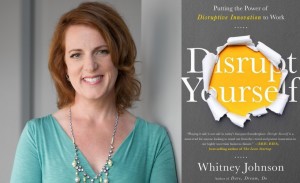 The twenties are time of much disruption. Whitney Johnson can help you leverage all the energy that comes with change towards accelerating your career. Her new book Disrupt Yourself: Putting the Power of Disruptive Innovation to Work defines her 7 principles of personal disruption. Get ahead start her with a two part discussion.
The twenties are time of much disruption. Whitney Johnson can help you leverage all the energy that comes with change towards accelerating your career. Her new book Disrupt Yourself: Putting the Power of Disruptive Innovation to Work defines her 7 principles of personal disruption. Get ahead start her with a two part discussion.
Aside from being an expert on how to apply the theory of disruptive innovation to your life, a leading career coach,speaker and co-founder of Rose Park Advisors, Whitney is my partner in Forty Women To Watch Over Forty. Not only is she is a disruptor herself, but she is always in inspiration to me to keep challenging myself.
~
Do you think young people just entering the professional workforce after college or school are naturally in a phase of self disruption? How can they leverage the theories of self disruption to navigate their first job?
For a 20-something starting a career everything is new – people, ideas, and places. As you work to achieve your pay-to-play career milestones, you may feel you don’t know what you are doing. This is normal at the low-end of your career learning curve. Once you get these basic skills, focus on what you do well that others in your organization don’t. These are what I call distinctive strengths. Play to them. Pair them with your pay-to-play skills and you’ll explode into competence and confidence. This is the exhilarating part of the curve – and your career.
In the book you talk about the S-curve of disruption starting off slowly before going to steep acceleration. What advice do you have for someone going through the slow part of the S curve? How do you know it is not just a bad move?
It’s true that the odds of success increase significantly when you pursue a disruptive course, but you still may fail. So the question is, what are some signs that you may be on the right curve? First, are you playing where other people aren’t? If so, and you feel a bit scared because you don’t know if there is a market, that’s actually a good sign, because market risk is less risky than competitive risk.
Second, are you playing to your strengths? What you do well that others don’t? Things that you do so well that when you receive compliments about that skill, you dismiss it, because for you this thing is as natural as breathing. If you use your superpowers everyday, you are more likely to be on the right curve. Third, how long have you been at it? If it’s less than six-months, and you are working a 40-hour work week, the 10,000-hour rule would suggest patience.
Finally, if it’s hard, but not frustrating, that’s another potential sign that you might be on the right curve. If all four of those variables are at play, then what you need is persistence. A willingness to keep going until you move into hyper growth, or have enough information to know that this isn’t the perfect curve for you, and it’s time to jump.
I often get 20-somethings asking how long they should stay at a job that doesn’t fulfill them before leaving — because they feel that what they do doesn’t matter/ isn’t valued. This often comes across as being “Entitled” Do you recommended they leave their job or that they seek to disrupt within and find something that matters in their first job to stay on a little longer.
Steve Jobs famously said that about half the difference between successful and non-successful entrepreneurs is perseverance. Usually, you need to stay a little longer. But also, remember that the next time you take a job, they may be hiring you, but you are hiring them, especially your boss. You need to know if that boss is going to sponsor you for stretch assignments and promotions. The best way to find that out is to find out where the last two people who had your role are. If they’ve gone on to something good, you probably can to.
Disrupt Yourself is one of the 100 Best Business Books in 2015, according to Inc. Magazine.
Find more on Whitney on Twitter @JohnsonWhitney
